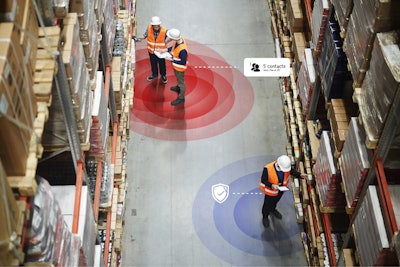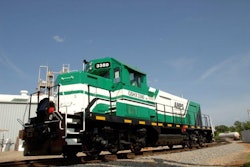
The recent innovations in automated and autonomous technologies have made sweeping changes across all industries. One of the most significant areas these technologies have impacted is warehouse systems.
Companies can use automated systems to improve their warehouse operations via machine-to-machine communication through unique networks.
What is machine-to-machine communication?
When people talk on the telephone, they communicate over cell towers or Wi-Fi, which is similar to how computers communicate. But, when people are in the same room, they speak directly, and when computers share directly, it is referred to as machine-to-machine (M2M) communication.
Today, most communications require fixed infrastructure (e.g., fiber optic cables, Ethernet, coaxial cables, cell towers, or Wireless Access Points). These limit communication coverage, but advancing applications like automation, autonomy, telematics and robotics require M2M, which extends coverage to perform efficiently.
Current M2M issues in warehouses
M2M wireless systems are great for making warehouse operations run at peak efficiency. They allow robotics and autonomous platforms to communicate with one another, helping to keep up with fulfillment demands, productivity speed, safety and accuracy. But too often, wireless systems in a warehouse face connectivity issues that obstruct them from an optimal workflow since most are dependent on line of sight (LOS) with fixed infrastructure.
Wi-Fi
Many warehouse systems run M2M communications through Wi-Fi on a fixed infrastructure. This means that the Wi-Fi signal is being sent from a singular location within the warehouse. Because it's stationary, Wi-Fi networks can have difficulty maintaining connectivity with autonomous systems, such as mobile robots. As different machines move around the warehouse floor, objects such as metal racks, handheld scanners and heavy equipment can disrupt the signal to these devices. Additionally, as these machines traverse across the warehouse floor, the distance away from the Wi-Fi also creates signal blockage issues. When the signal is interfered with, machines relying on M2M communication can stop functioning or fail to send the correct data to other essential devices.
Hand scanners
Many warehouses have factory workers that use hand scanners and RFID wands to send information about products or the supply chain to different systems. Like through a Wi-Fi network, when workers traverse the warehouse, interferences can affect coverage and signal strength. With spotty coverage, workers could potentially be scanning items to the system without the data getting read or knowing where it needs to be sent.
What is a mesh network?
Typically, warehouses experiencing signal blockage issues have only one way to solve them, and that is by adding more network infrastructure. This keeps annual maintenance costs increasing year-over-year vs. decreasing, and coverage gaps still exist. A mesh network should be considered by warehouse operators looking to solve connectivity issues and enhance their M2M communication.
A mesh system is a network enabling peer-to-peer communication that creates large-scale connectivity capable of multiple concurrent connections through various devices without the loss of communication. It allows modern warehouses to implement a self-optimizing and self-healing network, thus enabling continuous autonomous operations.
Network nodes can be placed on fixed and moving assets, allowing connectivity across the warehouse. As moving assets roam around the site, they can link directly with one another or on the fixed assets to enable M2M communication. These nodes enable longer range than Wi-Fi access points, by enabling peer-to-peer (M2M) communication and switch communication dynamically between machines and various infrastructure points allowing your warehouse to maintain constant communication with any mobile device or machine which improves productivity and reduces downtime.
How mesh networks improve warehouse communication
Day-to-day communication.
Using a mesh network allows your warehouse to operate at peak efficiency 24 hours a day, seven days a week. Because the connective nodes interact with one another, your warehouse will have less downtime on any given day. Your efficiency will increase on a day-to-day basis, allowing you to never break wireless communications through your system and meet warehouse demands.
Even in the hardest to network areas, such as between the racks, your machines can still receive a signal without adding significant infrastructure. Mesh M2M networks also allow warehouses to run other applications such as video streaming and telemetry for equipment.
Before acquiring a mesh network, do your research and talk to customers as some are optimized for fixed deployments, while others are designed to be fully mobile. Latency, throughput, range, scale (number of hops), number of radios, controller-based or controller-less are all factors to be researched and considered. All mesh networks are not created equal, and effectiveness is contingent on selecting the right mesh for the right applications.
Traffic routing
One of the most significant advantages of using the right mesh system is that it can create optimized traffic routes and allows traffic to be rerouted instantly. Should the wireless link of one of your moving robotic devices become blocked or interfered with, the mesh system will detect this and automatically reroute traffic through the next available radio link without outside intervention. The system will automatically create the most optimized wireless router to keep up with demand, think dynamic load balancing. This means that even when there is signal blockage communication is still upheld and information is successfully passed from device to device.
Equipment health
A mesh network allows warehouse operators to have a high capacity to run other efficient and transforming applications. While running the M2M warehouse system, operators can monitor the health of their equipment. This allows them to do any predictive maintenance on their machines before they break down.
When engineers conduct preventative measures on warehouse equipment, there is less of a chance for malfunctions, ultimately creating less system downtime and fewer warehouse delays. Predictive maintenance also gives machines a longer lifespan, saving money on frequent repairs or replacements.
Informed decision making
Using an efficient M2M communication system allows warehouses to access and use all the data that is being transferred from device to device in real time. In an effective mesh network, warehouse managers know there isn’t a gap in data collection. They can collect useful M2M data and create reports that allow warehouses to make informed decisions about their operations that they can use to make their system run more efficiently.
M2M communication—powered by mesh networks—has the potential to completely change the way warehouses operate in 2022 and beyond. Investing in these networks can enhance the company's warehouse workflow and lead to more efficient operations.



















